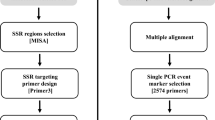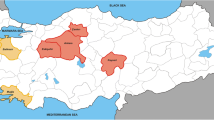Abstract
Microsatellite repeat sequences were investigated as sequenced-tagged site (STS) DNA markers to determine the potential for genetic analysis of the grapevine genome. The PCR-generated markers detect codominant alleles at a single locus or site in the genome. The marker type is very informative detecting high heterozygosity (69%–88%) within individual grapevine cultivars and high genetic variation between cultivars, making it a useful marker type for plant genome mapping and genome typing. For five loci a screening of 26 V. vinifera cultivars found 13, 12, 8, 5, and 4 different length alleles respectively with some alleles more common than others. The genomic DNA sequences surrounding microsatellite sequences were conserved within the genus permitting STS primers to amplify STSs from other Vitis species. These Vitis species were found to have some unique alleles not present in V. vinifera.
Similar content being viewed by others
References
Alleweldt G, Spiegel-Roy P, Reisch B (1990) Grapes (Vitis). In: Moore JN, Ballington Jr JR (eds) Genetic resources of temperate fruit and nut crops 1. Int Soc Hort Sci, Wageningen, pp 289–327
Beckmann JS, Soller M (1990) Toward a unified approach to the genetic mapping of eukaryotes based on sequence-tagged microsatellite sites Bio/Technology 8:930–932
Beyermann B, Nurnberg P, Weihe A, Meixner M, Epplen JT, Borner T (1992) Fingerprinting plant genomes with oligonucleotide probes specific for simple repetitive DNA sequences. Theor Appl Genet 83:691–694
Clingeleffer PR, Possingham JV (1988) Marroo Seedless: a new table grape variety. Agri Sci (Aust) 1:18–19
Edwards A, Hammond HA, Jin L, Caskey CT, Chakraborty R (1992) Genetic variation at five trimeric and tetrameric tandem repeat loci in four human population groups. Genomics 12:241–253
Hamada H, Petrino MG, Kakunaga T (1982) A novel repeated element with Z-DNA-forming potential is widely found in evolutionarily-diverse eukaryotic genomes. Proc Natl Acad Sci USA 79:6465–6469
Kwiatkowski DJ, Henske EP, Weimer K, Ozelius L, Gusella JF, Haines J (1992) Construction of a GT polymorphism map of human 9q. Genomics 12:229–240
Litt M, Luty JA (1989) A hypervariable microsatellite revealed by in-vitro amplification of a dinucleotide repeat within the cardiac muscle actin gene. Am J Hum Genet 44:397–401
Love JM, Knight AM, McAleer MA, Todd JA (1990) Toward construction of a high resolution map of the mouse genome using PCR-analysed microsatellites. Nucleic Acids Res 18:4123–4130
Mauro M-C, Strefeler M, Weeden NF, Reisch BI (1992) Genetic analysis of restriction fragment length polymorphisms in Vitis. J Hered 83:18–21
Moore SS, Sargeant LL, King TG, Mattick JS, Georges M, Hertzel DJS (1991) Conservation of dinucleotide microsatellites among mammalian genomes allows use of heterologous PCR primer pairs in closely related species. Genomics 10:645–660
Negrul AM (1938) Evolution of cultivated forms of grapes. CR Acad Sci USSR 18:585–588
Olmo HP (1976) Grapes. In: Simmonds NW (ed) Evolution of crop plants. Longman, London, pp 294–298
Olson M, Hood L, Cantor D, Botstein D (1989) A common language for physical mapping of the human genome. Science 245:1434–1435
Rychlik W, Rhoads RE (1989) A computor program for choosing optimal oligonucleotides for filter hybridization, sequencing and in-vitro amplification of DNA. Nucleic Acids Res 17:8543–8551
Schlotterer C, Amos B, Tautz D (1991) Conservation of polymorphic simple sequence loci in cetacean species. Nature 354:63–65
Soller M, Beckmann JS (1983) Genetic polymorphism in varietal identification and genetic improvement. Theor Appl Genet 67:25–33
Stallings RL, Ford AF, Nelson D, Torney DC, Hildebrand CE, Moyzis RK (1991) Evolution and distribution of (GT)n repetitive sequences in mammalian genomes. Genomics 10:807–815
Striem MJ, Spiegel-Roy P, Ben-Hayyim G, Beckmann J, Gidoni D (1990) Genomic DNA fingerprinting of Vitis vinifera by the use of multi-loci probes. Vitis 29:223–227
Tautz D (1989) Hypervariability of simple sequences as a general source for polymorphic markers. Nucleic Acids Res 17:6463–6471
Tautz D, Renz M (1984) Simple sequences are ubiquitous repetitive components of eukaryotic genomes. Nucleic Acids Res 12:4127–4138
Thomas MR, Matsumoto S, Cain P, Scott NS (1993) Repetitive DNA of grapevine: classes present and sequences suitable for cultivar identification. Theor Appl Genet 86:173–180
Weber JL (1990) Informativeness of human (dC-dA)n·(dG-dT)n polymorphisms. Genomics 7:524–530
Weber JL, May PE (1989) Abundant class of human DNA polymorphisms which can be typed using the polymerase chain reaction. Am J Hum Genet 44:388–396
Welsh J, McClelland M (1990) Fingerprinting genomes using PCR with arbitrary primers. Nucleic Acids Res 18:7213–7218
Williams JGK, Kubelik AR, Livak KJ, Rafalski JA, Tingey SV (1990) DNA polymorphisms amplified by arbitrary primers are useful as genetic markers. Nucleic Acids Res 18:6531–6535
Author information
Authors and Affiliations
Additional information
Communicated by J. S. Beckmann
Rights and permissions
About this article
Cite this article
Thomas, M.R., Scott, N.S. Microsatellite repeats in grapevine reveal DNA polymorphisms when analysed as sequence-tagged sites (STSs). Theoret. Appl. Genetics 86, 985–990 (1993). https://doi.org/10.1007/BF00211051
Received:
Accepted:
Issue Date:
DOI: https://doi.org/10.1007/BF00211051




